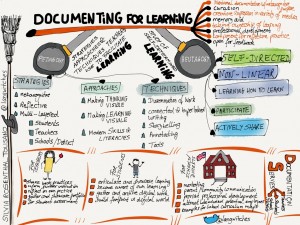This year, we are using Edublogs K-12 in our district. We’ve had only a few short weeks to introduce teachers to the platform officially (and some teachers may not lay eyes on it until after school officially opens), but many are up and running with their own sites. These teacher sites will be used to communicate with families and the rest of the school community, as well as facilitate blogging practices within the classroom. Our next step is to add student blogs to the My Class feature and get busy blogging!
When I think about blogging in schools, I envision communities where kids fluently use their spaces to reflect on learning, share with one another, post project work, ask questions, think critically, engage in conversation around one another’s ideas, and connect globally with peers. This isn’t always the reality, though. We might embark on the blogging adventure, gung-ho and full of enthusiasm about the possibilities, only to become easily drained by the day in and day out must-dos that zap our creative energies and cause us to fall back on what’s comfortable, what’s mundane. How can we keep the passion for documenting our learning alive and make the most of this powerful platform we’re given?
Last fall, I shared this bit about blogging while I was thinking through our blogging goals for the year. Some of our classes enjoyed many successes with blogging last year. Others dabbled, and still others didn’t include any type of blogging activities in the classroom. As the tech integrator, what are my next steps to help teachers feel comfortable with, and see the value in, this practice? Here’s what I’m thinking:
1. Show teachers what blogs can do to support learning. Provide a variety of examples of classroom and student blogs and blogfolios in action. Help teachers appreciate that the blog is a highly versatile platform through which students can document FOR learning, as described and illustrated by Silvia Tolisano here:

2. Get the leaders on board. And hands-on. As far as I am aware, none of our district administrators actively blog, either as a form of home-school communication or as professional practice. The impact of a digital age leader on his teachers, students, and school community cannot be underestimated. When leaders model, practice, and share these methods, it sets the example for the rest of the school community that this type of sharing, learning, and communication is valued.
3. Make sure teachers are comfortable with the technical ins and outs of the platform early on, so their energies and efforts can be focused on planning for learning. Edublogs and WordPress dashboards can be pretty mind-numbing to someone who is new to the platform. Once familiarized with the themes, menus, and settings, however, it’s a breeze to publish new posts and keep pages updated. I’ll front-load support in this area to help teachers conquer any techno-fears they have that might prevent them from digging deeper and planning to include blogging activities on a regular basis.
4. Help students own it. We must relinquish control to the learner whenever possible. Over blog themes, page heading, posting topics,widgets and styles, integrated blogging activities, with whom and how they connect to comment and engage in conversation, and how they document and share what they’ve learned. Give kids choice, promote their voices, and empower them as autonomous, responsible readers and writers. If I had someone constantly looking over my shoulder telling me I could or couldn’t post something on my blog, or that an idea wasn’t good enough to share publicly, or I needed to address every misspelling or grammatical error in my post to the point where it interfered with my creative flow, I’d probably grow weary of blogging, too.
5. Get classrooms connected. Try as I might, I don’t have enough time in the day to comment on every elementary classroom’s blogs. I wish I did! Helping teachers connect their students with others through Quadblogging, The Global Read Aloud, and #comments4kids will help amplify our students’ voices and forge lasting relationships with other students, teachers, and learning communities.
6. Support and inspire. After the initial honeymoon is over, teachers will likely be looking for ways for students to use their blogs more creatively, to make thinking visible. I’d love to see our kids develop their spaces into digital portfolios which can then be shared at student-led conferences. I will be sharing many resources from Silvia Tolisano, whose work on blogging I consider to be among the best, and from Sue Waters and the Edublogger community.
I’d love for you to share in the comments your advice for how I can best support teachers with blogging this year, as well as any go-to resources you have to inspire students and staff!
Photo Credit: Search Engine People Blog via Compfight cc

